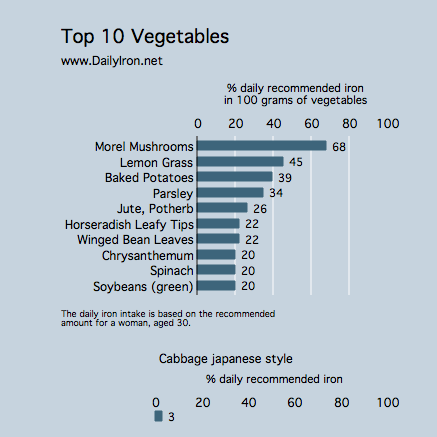Japanese cabbage contains .49 milligrams of iron per 100 grams. Grams is a measure of weight. To put 100 grams in perspective, consider alternative measures for this food:
- 1 cup equals 150 grams.
In the category of vegetables, we included whole vegetable products in the Top 10 list. We excluded dried/dehydrated products from the Top 10. You will find some dehydrated vegetables high in iron per 100 grams,but they tend to be far more volume than anyone would consume. Furthermore, foods may be fortified with iron but are not included in this Top 10 list. The food tested for the particular graph below can be described more specifically as:
Cabbage, japanese style, fresh, pickled
Read more about iron in vegetables or visit our iron-rich foods list.

Vegetables typically are not an exceptional iron source. Those vegetables that do contain iron also are more likely to be packed with iron blockers, making it difficult to absorb a great deal of the iron from the vegetables.
Nonetheless, even a vegetable with modest amounts of iron may play a substantial part in iron metabolism. Vegetables are often great sources of vitamin C, a vitamin that will actually help you metabolize the iron better in non-meat foods; Japanese cabbage is a poor source of vitamin C.
However, as an example you may wish to combine bell peppers and vine ripened tomatoes with a whole grain entree or with a bean-based dish to improve your digestion of the iron in your whole meal. A fresh mango treat with your dinner would help as well because of the vitamins in the fruit. A glass of fruit juice is a further an effective move.